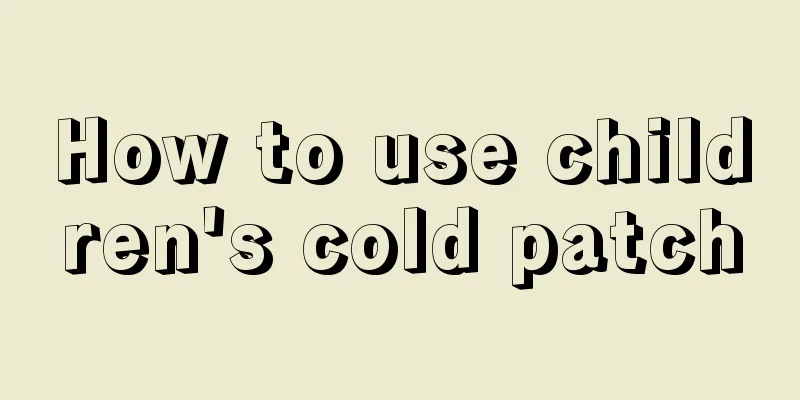What should I do if my child has pigeon-toed feet? How to correct it?

|
Most parents don't need to worry about their children walking with their feet turned inward, as the problem will usually recover on their own as the children grow up. If the pigeon-toed condition persists for a long time, a relevant diagnosis is needed. If there are occasional skeletal abnormalities, timely treatment is required. However, in most cases, it will recover on its own. In addition to congenital factors, acquired factors play an important role in this disease and it is preventable. Conservative treatment is generally suitable for children under 3 years old. The younger the age, the better the effect. The earlier the surgical treatment, the better the effect. The salten pelvic osteotomy changes the direction of the acetabulum into the normal physiological direction, relatively increases the depth of the acetabulum, and makes the femoral head and acetabulum reach the center. The age of indication is 1-6 years for hip dislocation, including those whose reduction by manipulation has failed. The acetabular index should be below 45 degrees, and the size of the femoral head should be basically adapted to the acetabulum, so that a good surgical effect can be obtained. I suggest you try to help your child correct it yourself first~~~ 1. To correct bowlegs, in addition to letting children sit, stand, walk and run in the correct posture, the following methods can be used: 1. Gait training method: let the child correct the step pattern, and have the adult count the commands and let the child walk slowly to the beat. The number of exercises, steps and time per day can be determined step by step according to the degree of the child's gait deformity and the length of time it has been formed, and should be adjusted accordingly. 2. Straight-line step method: Draw two straight lines on the ground with a spacing of about 10-15 cm. Let the child walk back and forth on the straight lines on his toes and heels, with the pace going from slow to fast. This kind of conscious training and persistence will have a very good effect. 3. Straight-line running method: Pull a bright plastic belt on the ground or draw a straight line with colored chalk, let the child stand with his feet parallel on both sides of the straight line, and let the child run along the straight line under the guidance of an adult. Do not let the child run with his feet splayed. In addition, to correct pigeon-toed feet, you can kick shuttlecock with the outside of your foot. When the footsteps are corrected, the child's normal walking will return to its original state. At this time, you should always pay attention and remind your child in time. If your child is calcium deficient, you need to supplement him/her with calcium. Prevent the child from developing bone deformities (bow legs, X-shaped legs, spinal curvature, etc.) and do not force the child to sit, stand or walk. It is best to let the child lie prone 2-3 times a day, with his head raised so that the chest can expand. On the basis of the above treatment, attention should be paid to diet, and egg yolks, animal livers, vegetables and fruits rich in calcium and phosphorus should be appropriately added. For example, jujube and hawthorn are high in calcium, while oranges and bananas are rich in phosphorus. For chest deformity, you can do exercises such as lying on your stomach and raising your head and expanding your chest. Lower limb deformities can be treated with muscle massage (massage the outer muscle groups for O-shaped legs and the inner muscle groups for X-shaped legs) to increase muscle tension and assist in the recovery of deformities. |
<<: Is childhood obesity hereditary?
>>: What kind of dance is good for children? It depends on the individual.
Recommend
What to do if your baby has blue eyes
Parents with children at home sometimes encounter...
Why babies don't gain weight
Some babies just can’t gain weight no matter how ...
What to do if your newborn is easily frightened
After a newborn is frightened, you must call out ...
Child rolling his eyes upward
In fact, rolling one's eyes upwards is a part...
Does it matter if you take X-rays of your newborn baby?
In our lives, when many newborns are sick, doctor...
Reasons why children sweat
It is summer now, so sweating has become a very n...
Why do teenagers sweat on their palms?
Sweating palms is quite common among teenagers, a...
Why is it that babies wake up easily when they sleep?
Babies have just come into this world and don’t k...
What to do if your 2-year-old baby is irritable and angry?
What should I do if my 2-year-old baby is irritab...
How to treat diarrhea in infants and young children?
Infant diarrhea is also called infant indigestion...
A complete collection of folk remedies for treating children's cough
Coughing in children is a relatively common disea...
How to clean the baby's nose
Newborn babies are very fragile and cannot withst...
Why does a child have a recurring fever in a week?
Young children have low resistance and immunity, ...
What should I do if my newborn has a lot of mucus in his right eye?
The physical health of newborns is an issue that ...
What are the symptoms of ADHD in children?
What are the symptoms of ADHD in children? This p...









